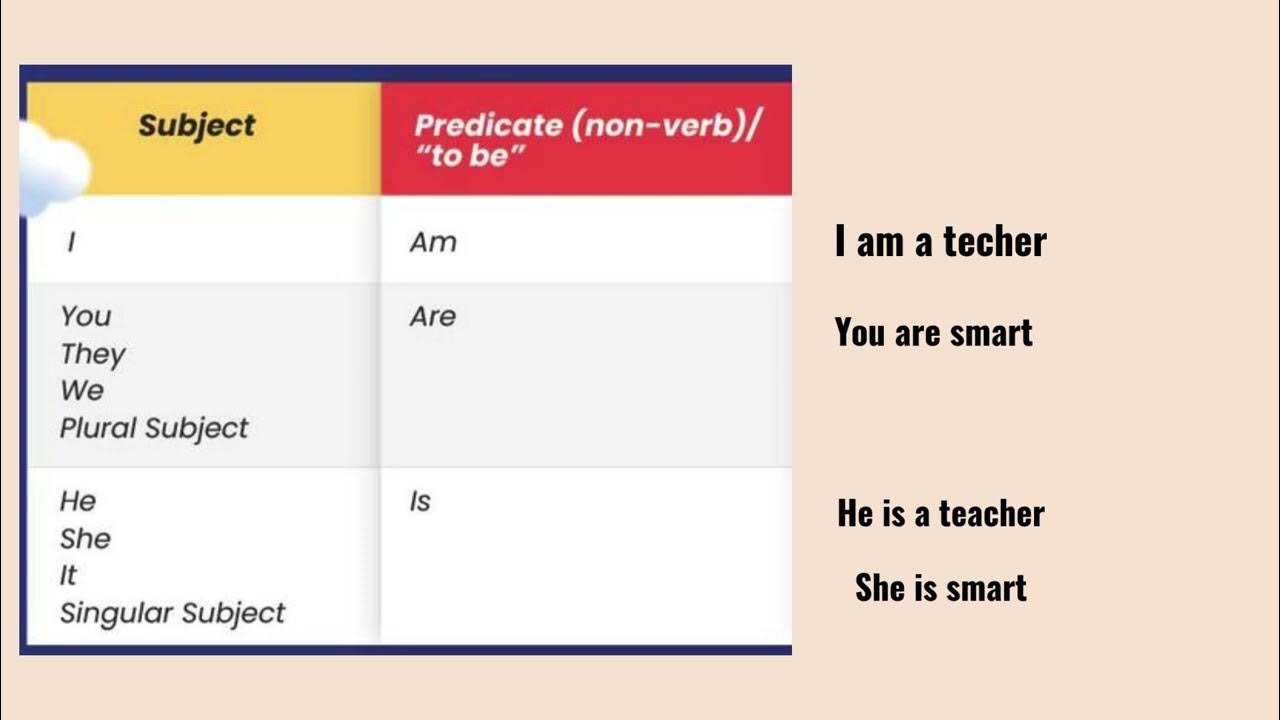MATERI TO BE (IS,AM,ARE) SIMPLE PRESENT TENSE
Summary
TLDRThis video script is an English lesson focusing on the use of 'to be' in the simple present tense. It explains the function of 'to be' as an auxiliary verb connecting subjects with adjectives or nouns. The lesson includes examples of correct usage with singular and plural subjects, as well as the formation of positive, negative, and interrogative sentences. It also clarifies common mistakes and provides clear examples to aid understanding, making it an informative resource for English learners.
Takeaways
- 😀 The video is an English lesson focused on the use of the verb 'to be' in the simple present tense.
- 📚 The script explains the use of 'to be' with different subjects such as 'I', 'you', 'he', 'she', 'it', 'we', and 'they'.
- 🔍 It clarifies that 'to be' is an auxiliary verb that cannot stand alone and must be followed by a noun or an adjective.
- 📝 Examples are provided to illustrate the use of 'to be' with nouns (like 'book', 'student') and adjectives (like 'happy', 'tall', 'beautiful') in sentences.
- 🎓 The lesson distinguishes between the use of 'is', 'am', and 'are' based on the subject.
- 👥 It discusses the formation of positive, negative, and interrogative sentences using 'to be'.
- 🤔 The script includes exercises to test understanding, such as choosing the correct form of 'to be' for given sentences.
- 📖 It mentions the use of 'to be' with singular and plural nouns and the corresponding verb forms.
- 📝 The lesson also covers the use of 'to be' in the simple present continuous tense, followed by a gerund (-ing form of a verb).
- 👨🏫 The video script is educational, aiming to help learners understand and correctly use the verb 'to be' in various contexts.
- 🙏 The presenter ends the lesson with a thank you and an apology for any mistakes, indicating a humble and interactive teaching style.
Q & A
What is the main topic of the English lesson in the script?
-The main topic of the English lesson is the use of 'to be' in the simple present tense.
What does the term 'chubby' refer to in the context of the script?
-In the script, 'chubby' seems to be a term used to describe the structure of the lesson or the way it is presented, possibly referring to its comprehensiveness or fullness of content.
What is the purpose of the word 'am' in the simple present tense?
-The word 'am' is used as an auxiliary verb in the simple present tense to link the subject with the predicate, especially when the subject is 'I'.
How is the word 'is' used in the simple present tense for subjects other than 'I'?
-The word 'is' is used with third-person singular subjects, such as 'he', 'she', or 'it', to form the simple present tense.
What is the role of the word 'are' in forming sentences in the simple present tense?
-The word 'are' is used with plural subjects or with the pronoun 'you' to indicate the simple present tense.
Can the word 'to be' stand alone in a sentence, or does it need to be followed by another word?
-The word 'to be' cannot stand alone; it needs to be followed by a noun, pronoun, or adjective to complete the meaning of the sentence.
What is the difference between using 'is' and 'are' in the context of the lesson?
-The difference lies in the subject of the sentence. 'Is' is used with singular third-person subjects, while 'are' is used with plural subjects or the second-person pronoun 'you'.
How does the script explain the use of 'to be' with singular nouns?
-The script explains that 'to be' should be followed by a singular noun, and the correct form of 'to be' is 'is' in this case.
What is an example of a sentence using 'to be' with a singular noun provided in the script?
-An example given in the script is 'The book is expensive', where 'is' is used with the singular noun 'book'.
How can you form a negative sentence in the simple present tense using 'to be'?
-To form a negative sentence, 'not' is added after 'to be'. For example, 'I am not hungry' uses 'am not' to express a negative state.
What is the correct way to form a question using 'to be' in the simple present tense according to the script?
-To form a question, the order of 'to be' and the subject is reversed. For example, 'Are you hungry?' is a question formed with 'are' and 'you'.
Outlines

This section is available to paid users only. Please upgrade to access this part.
Upgrade NowMindmap

This section is available to paid users only. Please upgrade to access this part.
Upgrade NowKeywords

This section is available to paid users only. Please upgrade to access this part.
Upgrade NowHighlights

This section is available to paid users only. Please upgrade to access this part.
Upgrade NowTranscripts

This section is available to paid users only. Please upgrade to access this part.
Upgrade Now5.0 / 5 (0 votes)





